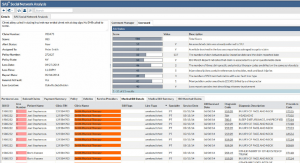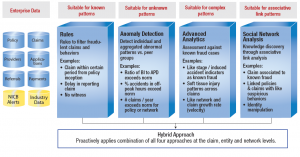 This is the fifth of the seven parts of blog post series “A practical guide to tackle auto insurance fraud”.
This is the fifth of the seven parts of blog post series “A practical guide to tackle auto insurance fraud”.
In the first four articles of the series we drilled down to Data Management and Data Quality as the basis for fraud detection analytics, to Business Rules and Watch lists techniques that play always a crucial role for claim handlers and fraud investigators, to Advanced Analytics which add a layer of defensed towards the unknown fraud typologies that more experienced and organized fraudsters utilize and to the most powerful advanced analytics technique of Social Network Analysis for uncovering hidden relationships between all involved parties and entities in a claims and not only process.
This 5th article of the series gives a practical guideline of what you should do in order to combine all of the above techniques in a fraud risk scoring process. With this way, a fraud risk score for every claim will highly assist you to prioritize needed actions, to focus your time and energy only to highly suspicious cases and to stop chasing ‘shadows’.
Scoring Framework
Although an insurer may have built a business rules based process for identifying claims fraud suspicious cases (e.g. a claim few weeks before/after the end or start of the policy, a claim between 01.00-06.00 am etc.), this cannot guarantee efficient detection results, but the opposite. Counting how many rules are being violated triggers a lot of false positives, a lot of cases wrongly characterized like fraud, spending valuable resources for investigation without any reward.
This because not every rule has the same impact, the same severity. Also a combination of two rules can have greater or lower severity than the sum of the individuals. Taking into consideration also, that in a holistic fraud detection approach except of Business Rules and Watch lists technique, additional techniques like Advanced Analytics and Social Network Analysis (SNA) have to be utilized, applying different severities in this spectrum becomes a science approach that needs specific methodology and analytics techniques to be applied.

Scoring Framework: Total fraud risk score per claim, based on individual risk scores and severities per rule and any other analytics technique
This is what we call a Fraud Risk Scoring Framework, a combination of IP and methodology, that can be applied and provide one single unique score or multiple scores (e.g. different view of business rules score and SNA score) for every claim.
Hybrid scoring techniques
The scoring framework will provide a Hybrid score based on the combination of several techniques, e.g. Business Rules, Watch lists, Anomaly Detection, Social Network Analysis etc.
Each rule derived either by business logic or analytics process must have a severity level, a unique individual score based on probability, if the rule is violated, to indicate a suspicious fraud case.
As an example a matching of a claimant in a fraud watch list, that indicates his involvement in a past fraud case, has higher severity and higher score than a claim that have been submitted few weeks after the actual accident. Another example can be that a claim reported at the end period of a policy, has higher severity for a standard policy instead of a corporate or leasing vehicle (in such policies it is usual all vehicle damages and claims to be reported at the end of the leasing period).

Hybrid Scoring: Combination of several fraud detection techniques
The definition of each rule’s individual score, each individual severity, is not an ‘art’ and definitely it must not be based on investigator’s gat filling or intuition! Each individual score has to be supported by analytics for past detected cases, meaning that some statistical analysis should be applied in the historical claims data and calculate the severity of each rule.
Scoring Calibration
Applying statistical analysis to derive fraud risk scores does not mean that business expertise is not welcome. In cases where the insurer did not track down fraudulent claims or past data are poor in completeness or quality for the rules to be statistically examined, business expertise is mandatory. However, even if the insurer selects the approach of defining the severity of each rule by expert judgment, later on the statistical approach must be utilized upon collecting properly new data. The data driven statistics have to cross check that the applied individual scores via business expertise are validated by the actual facts and, as expected, needed scoring calibrations and modifications will be triggered.
Key message
While applying a series of analytics techniques in a fraud detection process it is mandatory and high important the insurer to be able to combine all of this intelligence in a unique per claim hybrid score.
Specialized fraud prevention software needs to include such a scoring framework. The insurer should be aware that by not having such technology that provides with high accuracy fraud risk scores, false positives will be high much energy, time and resources will be wasted without any return.
This is the 5th post in a 7-post series, “A practical guide to tackle auto insurance fraud”. This series explores 7 analytics best practices techniques that insurers need to follow for tackling auto insurance claims fraud. Next post deals with the Investigator’s Interface, a graphical user interface that prioritizes the claims fraud alerts, provides all needed information for the investigator and assists towards exploration of each case with matching past incidents and visualizing the evolution of the fraud rings over time.
For a deeper insight, don’t miss to watch the on-demand Insurance Fraud webinar series that were completed on September

4 Comments
Pingback: A practical guide for auto insurance fraud – Opening Welcome - Bright Da
Pingback: A practical guide for auto insurance fraud – Opening Welcome - Bright Da
Pingback: A practical guide to tackle auto insurance fraud - Part 6: Fraud Investigator interface
Pingback: Insurance fraud: a practical guide to tackle it - operational processes and automated controls